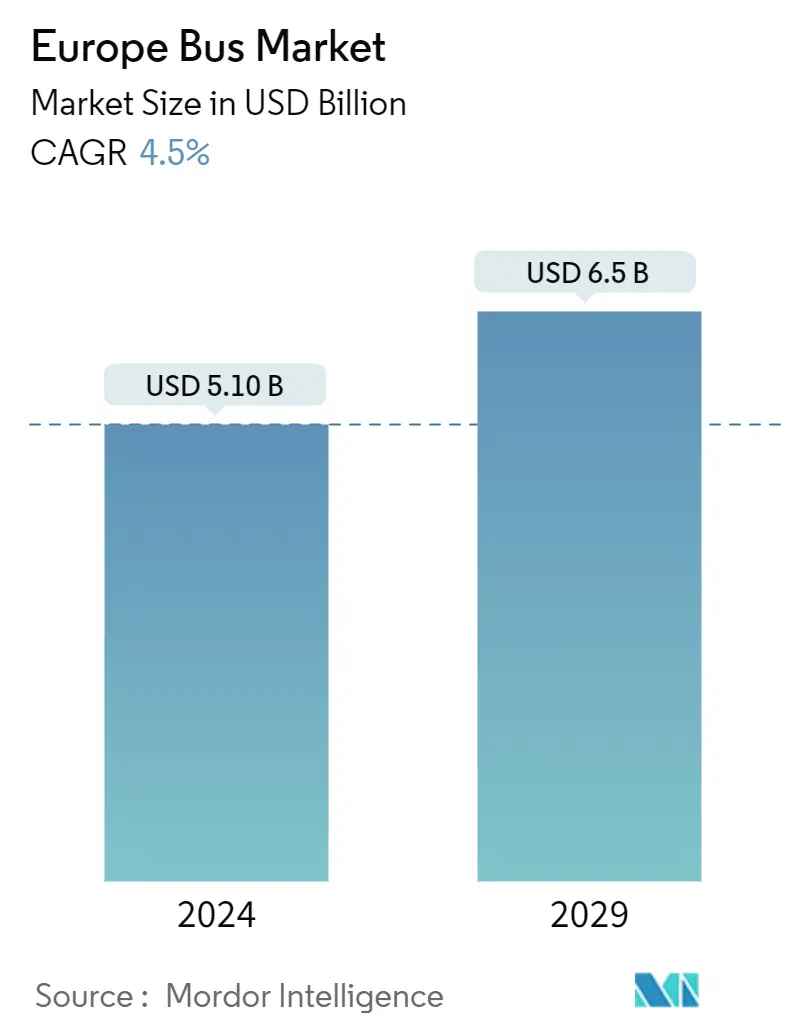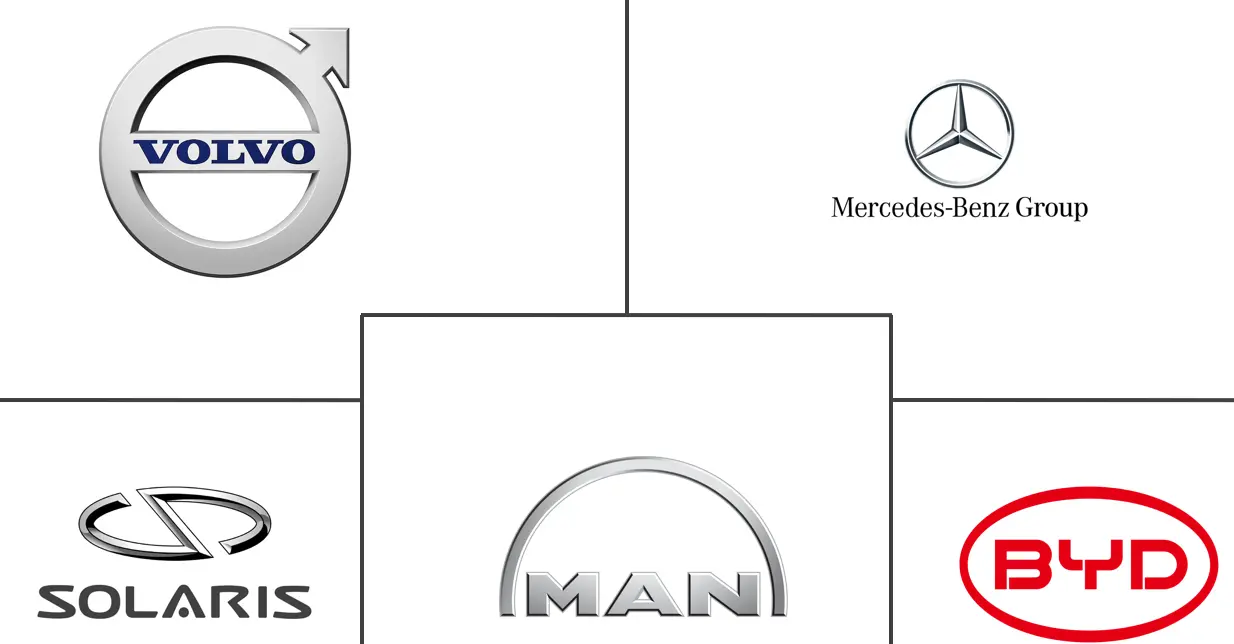Market Size of Europe Bus Industry

| Study Period | 2018-2029 |
| Base Year For Estimation | 2022 |
| Market Size (2024) | USD 5.10 Billion |
| Market Size (2029) | USD 6.5 Billion |
| CAGR (2024 - 2029) | 4.50 % |
| Market Concentration | Medium |
Major Players
*Disclaimer: Major Players sorted in no particular order |
Europe Bus Market Analysis
The Europe Bus Market size is estimated at USD 5.10 billion in 2024, and is expected to reach USD 6.5 billion by 2029, growing at a CAGR of 4.5% during the forecast period (2024-2029).
Over the long term, factors such as an increase in the adoption of electric buses, rising urbanization, stringent emission regulations, and deployment of autonomous technologies in buses drive the bus market in Europe. For instance, in October 2023, India-based electric bus maker JBM Electric Vehicles presented two of its latest e-bus products at the ongoing Busworld Europe 2023 expo in Brussels.
Clean technologies in public transportation are more and more needed in the current scenario to cope with air pollution in urban areas. The demand for electric buses in Europe has augmented dramatically over the last decade.
As cities and urban areas continue to expand, the need for efficient and sustainable public transportation systems becomes crucial. Buses play a vital role in meeting this demand, offering a cost-effective solution for mass transit. Governments and city authorities are investing in bus fleet expansion and modernization to improve public transportation infrastructure and reduce congestion and emissions.
In 2023, the United Kingdom government announced to spend USD 61 billion on public transport system and help the country meet its net zero goals. Thus, the above factors, combined with advances in transportation systems, will drive market growth.
Europe Bus Industry Segmentation
The bus plays an important part in the transportation industry, catering to various passenger transportation needs. Buses serve as an efficient mode of transportation for both urban and intercity travel, school transportation, tourism, and more.
The European bus market is segmented by deck type, application, fuel type, seating capacity, length, and country. By deck type, the market is segmented into single and double. By application, the market is segmented into transit buses, intercity buses, motorcoaches, school buses, and other applications. By fuel type, the market is segmented into diesel, battery electric, plug-in hybrid, fuel cell electric, and other fuel types. By seating capacity, the market is segmented into up to 30 seats, 31–50 seats, and more than 50 seats. By length, the market is segmented into up to 9 meters, 9–12 meters, and more than 12 meters. By country, the market is segmented into Germany, the United Kingdom, France, Russia, Spain, and the Rest of Europe.
The report offers market size and forecasts for the Europe bus market in value (USD) and volume (units) for all the above segments.
Europe Bus Market Size Summary
The European bus market is poised for significant growth, driven by the increasing adoption of electric buses and advancements in public transportation technologies. As urbanization continues to rise, the demand for efficient and sustainable mass transit solutions becomes paramount. Buses, particularly electric and battery-electric models, are central to this transformation, offering a cost-effective means to reduce congestion and emissions in urban areas. The market is further bolstered by supportive government policies, investments in infrastructure, and the deployment of autonomous technologies. These factors collectively contribute to the market's expansion, with a focus on achieving net-zero emissions and enhancing public transport systems across Europe.
The market landscape is characterized by the presence of established global and regional players who are actively engaging in strategic initiatives such as product launches, collaborations, and mergers to maintain their competitive edge. Companies like Volvo Buses, Mercedes Benz Group AG, Solaris Bus & Coaches, MAN Truck & Bus, and BYD Company Limited are at the forefront, introducing innovative bus models and expanding their electric vehicle offerings. The introduction of new models, such as double-decker and low-entry buses, along with the development of charging infrastructure, underscores the industry's commitment to sustainable transportation solutions. As a result, the European bus market is expected to witness robust growth, with electric buses holding a significant share due to their environmental and economic benefits.
Europe Bus Market Size - Table of Contents
-
1. MARKET DYNAMICS
-
1.1 Market Drivers
-
1.1.1 Increasing demand for New Energy Buses
-
-
1.2 Market Restraints
-
1.2.1 Reduced Subsidies on Electric Buses
-
-
1.3 Porter's Five Forces Analysis
-
1.3.1 Bargaining Power of Suppliers
-
1.3.2 Bargaining Power of Buyers/Consumers
-
1.3.3 Threat of New Entrants
-
1.3.4 Threat of Substitute Products
-
1.3.5 Intensity of Competitive Rivalry
-
-
-
2. MARKET SEGMENTATION
-
2.1 Deck Type
-
2.1.1 Single
-
2.1.2 Double
-
-
2.2 Application
-
2.2.1 Transit Bus
-
2.2.2 Intercity Bus/Motorcoaches
-
2.2.3 School Bus
-
2.2.4 Other Applications
-
-
2.3 Fuel Type
-
2.3.1 Diesel
-
2.3.2 Battery Electric
-
2.3.3 Plug-in Hybrid
-
2.3.4 Fuel Cell Electric
-
2.3.5 Other Fuel Types
-
-
2.4 Seating Capacity
-
2.4.1 Up to 30 seats
-
2.4.2 31-50 seats
-
2.4.3 more than 50 seats
-
-
2.5 Length
-
2.5.1 up to 9 meters
-
2.5.2 9-12 meters
-
2.5.3 more than 12 meters
-
-
2.6 Country
-
2.6.1 Germany
-
2.6.2 France
-
2.6.3 United Kingdom
-
2.6.4 Spain
-
2.6.5 Rest of Europe
-
-
Europe Bus Market Size FAQs
How big is the Europe Bus Market?
The Europe Bus Market size is expected to reach USD 5.10 billion in 2024 and grow at a CAGR of 4.5% to reach USD 6.5 billion by 2029.
What is the current Europe Bus Market size?
In 2024, the Europe Bus Market size is expected to reach USD 5.10 billion.

